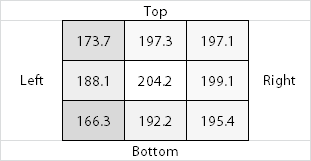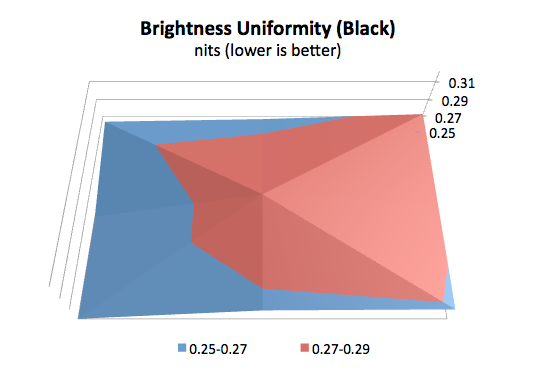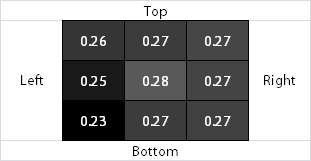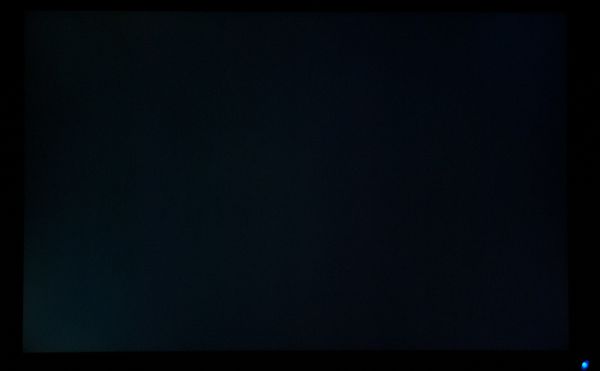Dell U3011 Review: Dell's New 30-inch Flagship
by Brian Klug on January 13, 2011 9:17 PM ESTBrightness Uniformity
For brightness uniformity, we test at the same 9 points we measure Delta-E on, but this time measure white and black levels when the center point is as close to 200 nits as we can get. We use the same colorimeter and software as before, - an Xrite i1D2 and ColorEyes Display Pro. Similar to the ordinary brightness test (taken at the center), contrast is set to 100 in the OSD and brightness is set to as close to 200 as possible in the center before measurements are taken.
White Uniformity


Black Uniformity


In both of these, there's a very obvious horizontal brightness dependence. The display is just a bit brighter at the far right than the far left, which also nicely explains why the top right and bottom left (extremes of brightness) also seem to have the highest Delta-Delta-E (as shown on the color uniformity page).
The brightness irregularity measured here isn't readily visible, in fact in the dark it subjectively looks the other way around (or at least how my camera captured it). I measured both twice and got similar results.











123 Comments
View All Comments
IceDread - Friday, January 14, 2011 - link
Good review!I read the ZR30w review earlier and that's the monitor I'd like to purchase when I upgrade from my 24" screen.
Input lag matters as does colour.
I have a hp 24" and tried a dell 24" which was 100$ more expensive and the hp had better colours and better (lower) input lag. It feels like Dell is falling behind HP.
MeanBruce - Friday, January 14, 2011 - link
I agree, Dell is falling behind! I have owned three Dell Ultrasharp panels loved all of them, amazing color DisplayPort when no one else had it. I am looking for a 27" now and have no idea what to purchase. Anand says even the Apple displays are really not as amazing as their cost would dictate, and zero ports on those things. Does anyone make a glossy 27inch RBG LED with ports for $1200?misterjohnnyt - Friday, January 14, 2011 - link
Made In china = GARBAGE, sure to fail quickly.Oh, and if you buy chinese junk, you are also supporting extreme human rights violations, slavery, forced child labor, fascism, evil, environmental raping, and the downfall of America.
Alexstarfire - Friday, January 14, 2011 - link
Is that a joke? I only ask because I doubt you don't own or haven't purchased anything that was made in china.AnnihilatorX - Friday, January 14, 2011 - link
I have my Dell U2711, a pity it supports HDMI1.3 as 1.4 specification allows 4k resolutions.1.3a only supports 1920*1080, which means display port or DVI is still required for PC connections. Can't blame U2711 of not having it since 1.4 wasn't ready back then, but not having 1.4 support on product that's just came out is not forward thinking enough
DanNeely - Friday, January 14, 2011 - link
HDMI 1.4 only supports 4k at 24/30FPS. To do it at 60 FPS you need displayport 1.2.AnnihilatorX - Saturday, January 15, 2011 - link
Oh didn't know that. What a crappy interface :)I am not a big fan of HDMI to begin with, but all AV receivers nowadays uses HDMI.
DanNeely - Saturday, January 15, 2011 - link
HDMI is designed by and for the TV industry, anything not needed for that is generally not included. 1.0 was a single link DVI interface. 1.1 and 1.2 just added additional audio formats. 1.3 doubled the bandwidth (to DVI levels) allowing higher resolutions (2560x1600), bit rates, more audio formats, and 100mbit ethernet over a sub channel. 1.4 added 3d and 4k support, but unless 2560 or 4k devices start moving towards high end consumer TV installations there really isn't any need for higher resolution support in the home theater market.DisplayPort is aimed at computer users and goes higher end. In the short term though it's double bandwidth will probably be used mostly to multiplex displays. AMD's 6xxx cards take advantage of this for eyefinity by allowing you to connect 3 displays to a single DP port using a breakout box. This will also simplify cabling for large video wall type installations.
James5mith - Friday, January 14, 2011 - link
Everyone should have one of those Husky Torx drivers. They are extremely cheap, like $5-$6 and are super compact and easy to carry in any bag or toolkit. They come in handy all the time in the tech world, and no geek should be without one for the price.Brian Klug - Friday, January 14, 2011 - link
Totally agreed, I've got that Husky Torx set and another with normal phillips/slot bits that have literally paid for themselves a thousand times over with how many things I've repaired using them. :)-Brian